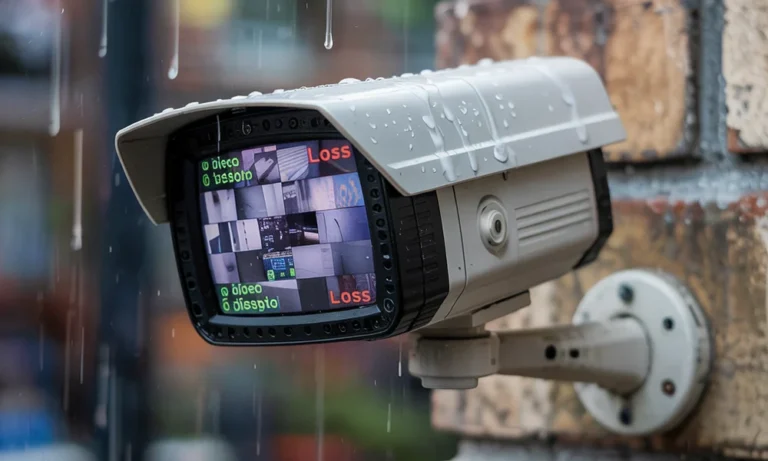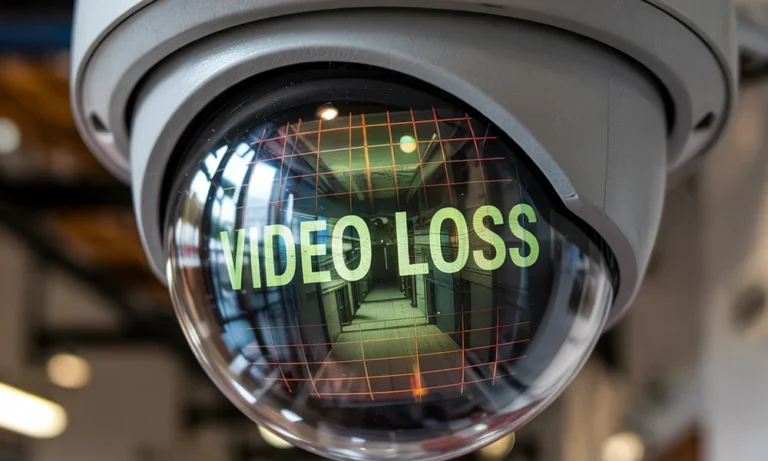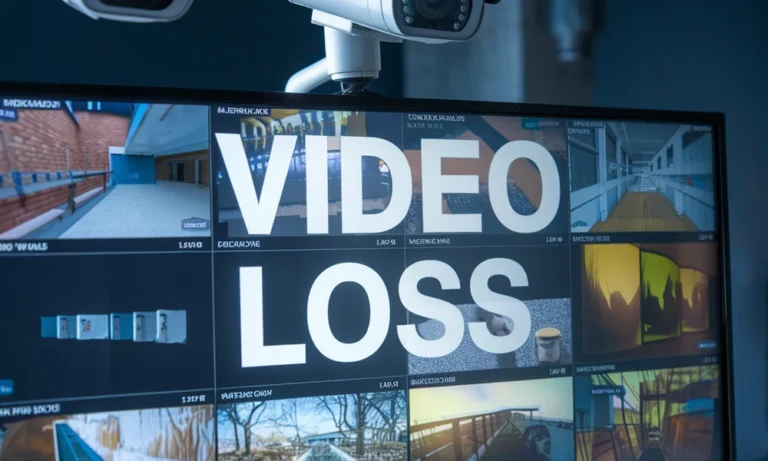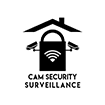What causes video loss in security cameras is a common concern for both home and business owners who rely on surveillance systems to protect their property. Systems for video surveillance are essential for improving security, allowing real-time monitoring, and providing useful evidence in the event of an incident. However, when these systems fail specifically through video loss on security camera it can leave critical blind spots and compromise safety. This post will explore the reasons behind video loss, what it means when it happens, and how you can troubleshoot and fix it to keep your security system running smoothly.
What is Video Loss on Security Cameras?

In the context of CCTV and IP cameras, video loss refers to the failure of a camera to transmit video footage to the recording device or monitor. This issue can prevent users from seeing live feeds or accessing recorded footage, posing serious security risks. The term CCTV camera video loss is commonly used to describe this problem in analog systems, while CCTV video loss may also apply to digital or IP-based camera systems.
Types of Video Loss
There are three main types of video loss:
- Temporary Video Loss
This occurs briefly and usually resolves on its own. It might happen during a system reboot, network hiccup, or power fluctuation. - Intermittent Video Loss
The feed cuts in and out over time. This type of loss is often due to unstable power supply, loose connections, or failing hardware. - Complete Video Loss
The camera feed is entirely unavailable and does not recover without intervention. This could be due to a hardware failure, severed cable, or network outage.
What Users Typically See
When CCTV camera video loss occurs, users often notice:
- A black screen
- A “no signal” message
- Frozen frames, where the last captured image stays on-screen but doesn’t update
These signs indicate that the video feed has been disrupted or lost entirely.
Understanding What Causes Video Loss in Security Cameras

Power Supply Issues
An issue with the power supply is among the most frequent reasons why CCTV footage is lost. Security cameras require a consistent power source, and disruptions can lead to intermittent or complete video loss. Issues may include faulty power adapters, damaged power cables, or power supply unit failure. Surge problems, especially during storms or electrical fluctuations, can also damage internal components, leading to the loss of video feed.
Faulty or Loose Cables
Cable-related issues are another frequent reason for security camera video loss. For analog CCTV systems, problems with coaxial cables—such as fraying, kinks, or poor connectors—can interrupt the video signal. In IP camera setups, Ethernet cable issues are common, especially if there’s a bad connection to a POE (Power over Ethernet) switch or the cable run exceeds recommended distances. Always check that cables are properly seated and undamaged.
Camera Hardware Failures
Sometimes the source of the CCTV video loss is internal. Cameras can experience hardware failures at the board or sensor level. This might result from manufacturing defects, age, or exposure to extreme environmental conditions. Overheating—especially in poorly ventilated enclosures—can degrade components over time, leading to permanent video loss.
DVR/NVR Malfunction
If the DVR (Digital Video Recorder) or NVR (Network Video Recorder) is malfunctioning, it can result in loss of recorded footage or live feed. Bad hard drives, corrupted firmware, or overheating units are common culprits. A firmware update or system reset can sometimes fix these issues, but failing hardware often requires replacement.
Interference or Signal Disruption
In wireless systems, interference from other electronic devices—like routers, microwaves, or cordless phones—can cause security camera video loss. Additionally, when video is transmitted over long distances without the use of signal boosters or repeaters, the signal may weaken to the point of being unusable.
Network Problems (for IP Cameras)
IP cameras are particularly susceptible to network-related issues. Limited bandwidth, especially on busy networks, can result in video feeds freezing or disappearing. Misconfigured routers or switches, as well as IP conflicts (when two devices share the same IP address), can prevent cameras from connecting to the system properly, causing CCTV video loss.
Environmental and External Factors
Lastly, environmental conditions can also lead to video issues. Harsh weather such as rain, snow, or extreme heat can damage external camera components or impair visibility. Vandalism or intentional tampering—such as cutting cables or redirecting cameras—can also cause immediate and complete video loss.
If you want professional cctv installation in Indianapolis then contact no other than Cam Security Surveillance.
How to Fix Video Loss Issues
Basic Troubleshooting
Before diving into complex fixes, start with these essential checks:
- Check the power source: Ensure the camera is receiving power. Test outlets, inspect the power adapter, and verify any battery backups if used.
- Inspect cables and connectors: Loose, frayed, or damaged cables are common causes of CCTV camera video loss. Secure all connections and look for any visible wear.
- Reboot the system: Power cycle your cameras, DVR/NVR, and network equipment.Temporary issues can frequently be fixed with a simple reboot.
For Wired Cameras
Wired setups, especially older analog systems, need specific attention:
- Replace faulty cables: Swap out old or damaged coaxial or Ethernet cables to restore a clear video signal.
- Test with alternative power adapters: If a camera isn’t powering up, try a different adapter with matching specs to rule out a faulty power source.
- Try different DVR/NVR inputs: A bad input port on your recording device could be the issue. Plug the camera into another channel to check if the video loss persists.
For IP Cameras
IP-based systems can experience video loss due to network issues. Here’s how to handle them:
- Check PoE switch and router settings: Ensure the PoE switch is providing adequate power and that your router isn’t blocking the camera through security or bandwidth restrictions.
- Reassign IP addresses: Avoid IP conflicts by assigning unique static IP addresses to each camera. Duplicate addresses often cause connection and video loss.
- Update firmware: Outdated firmware can lead to bugs or compatibility issues. Always install the latest firmware from the manufacturer to maintain a stable connection.
Preventative Measures
To reduce the chances of encountering security camera video loss in the future, consider these long-term solutions:
- Use surge protectors: Protect your equipment from power surges, especially in areas prone to lightning or electrical instability.
- Install weatherproof housings: Outdoor cameras need protection from rain, snow, and extreme temperatures to avoid environmental damage.
- Perform regular maintenance checks: Periodically inspect your entire system, including cables, power supplies, and recording devices, to catch early signs of wear or failure.
When to Call a Professional

DIY troubleshooting can be a great first step when dealing with issues related to your CCTV system. However, there are certain situations where it’s best to call in a professional. Let’s explore when you should seek expert help for your security camera system issues.
1. Persistent CCTV Video Loss
If you’re experiencing CCTV video loss that persists despite your best efforts to troubleshoot, it may indicate a deeper issue that DIY methods can’t resolve. Damaged wires, malfunctioning equipment, or even problems with your DVR or NVR can result in video loss. A professional from Cam Security Surveillance can diagnose and fix the problem quickly, ensuring your system is up and running again without any further disruptions.
2. Loss of Security Camera Video Following Equipment Movement or Adjustment
If your system was working fine before moving or adjusting your cameras, and now you’re facing video loss, this could be due to misalignments, damaged connections, or a need for reconfiguration. While you might attempt to reconnect cables or reset the system, professionals will be able to ensure everything is properly aligned and functioning, restoring your system to full working order.
3. Problems Beyond Simple Repairs
If the issue requires replacing parts or rewiring components, it’s advisable to call a professional. DIY troubleshooting can only take you so far when dealing with issues like faulty power supplies, broken cables, or malfunctioning cameras. If these issues aren’t addressed properly, they can result in further damage or even void your warranty.
4. Warranty and Tech Support Options
If your CCTV system is still under warranty, Cam Security Surveillance is here to help! Contacting the manufacturer’s tech support or our professional technicians can save you time and money. Many warranties provide coverage for parts and repairs, so it’s best to consult with experts who can ensure you don’t void your warranty while making repairs.
5. When You Need a System Upgrade or Expansion
Sometimes, the issue isn’t with your current system but with its limitations. If you find that your CCTV setup no longer meets your needs, whether that’s adding more cameras, improving storage, or upgrading to higher-resolution video, it’s time to call a professional. Cam Security Surveillance can help assess your needs and provide tailored solutions to expand and improve your security setup.
6. When You’re Not Sure What’s Wrong
Sometimes, it’s simply not clear what’s causing the issue with your security camera system. If troubleshooting and basic fixes don’t work, a professional technician from Cam Security Surveillance can pinpoint the problem and provide an efficient solution.
Final Thoughts
Faulty wires, bad connections, problems with the power supply, or broken cameras can all result in video loss in security cameras. It may also occur if the DVR/NVR system experiences hardware failure or signal interference. Basic troubleshooting can resolve certain problems, but specialist knowledge is needed for others. If you can’t diagnose the problem yourself, contact Cam Security Surveillance. Our experts are here to quickly resolve your CCTV issues. Call us today at +1 (317) 531-2975 for assistance!
FAQs
What Are The Most Common Causes Of Video Loss In Security Cameras?
The most common causes of video loss in security cameras include faulty cables, loose or damaged connections, power supply issues, malfunctioning cameras, or problems with the DVR/NVR system. Environmental factors, such as interference or poor signal transmission, can also contribute to video loss.
Can A Power Surge Cause Video Loss In Security Cameras?
Yes, power surges can damage the camera’s internal components or the DVR/NVR system, leading to video loss. It’s important to use surge protectors to prevent damage to your system from electrical fluctuations.
How Can I Fix Video Loss Caused By Faulty Cables?
If video loss is due to faulty cables, check the cable connections for any signs of damage or wear. Replace any broken or frayed cables and ensure that all connections are secure. If the issue persists, a professional technician may be needed to check for deeper wiring problems.
What Should I Do If My Security Cameras Are Still Powered On But Show No Video?
If your security cameras are powered on but show no video, it could be a sign of a malfunctioning camera, a DVR/NVR issue, or poor connections. Try rebooting the system and checking all cables. If the problem continues, you may need professional assistance to diagnose and fix the issue.
Can Video Loss Occur Due To Network Issues With Ip Cameras?
Yes, video loss can happen with IP cameras if there are network issues such as bandwidth limitations, poor Wi-Fi signal, or faulty routers. Ensure that your network is stable and that the cameras are receiving adequate power and connectivity.








